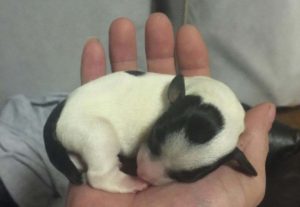Link, an 8 year old Doxie, was in trouble.
Externally, he was bright yellow (jaundiced), had been vomiting, and hadn’t eaten for a few days.
Fortunately, instead of procrastinating, Link’s owner took him to his family vet, who ran blood work.
It showed elevated liver enzymes.
Based on those results, an abdominal ultrasound was wisely recommended.
Internally, something bad was brewing.
Link had an enlarged gallbladder. His condition led to an increase in mucus and dehydration of the bile, which means the bile couldn’t flow normally into the intestine. It started to build up inside the gallbladder, which became bigger and bigger. This is a classic case of a mucocele (pronounced “mew – ko – seal”).
Immediate surgery was recommended… before the gallbladder ruptured and turned a bad situation into a life-threatening disaster.
Link’s owner remembers: “We knew how serious his condition was because our family vet told us what the alternative to surgery was euthanasia. Our weekend was very sad as we thought we were going to have to euthanize him. We were just concerned because every place was closed or unaffordable.”
As soon as we received the call from Link’s owner, we told him to bring Link for immediate emergency surgery.
Link’s owner shared: “When I found out you were going to accept him, we were ecstatic!”
He had mixed emotions before surgery: “We were very worried about him, but relieved as well since he was getting the surgery he needed.”
Once the belly was open, we found a bad surprise: the gallbladder has already ruptured!
This led to one or two possibly deadly conditions:
1. Chemical peritonitis, because the chemicals in bile cause irritation or inflammation of the belly, called peritonitis.
2. Septic peritonitis, because bile commonly contains evil bacteria that can cause an infection in the belly.
So we removed the gallbladder as quickly as possible (this surgery has a fun name: chole-cystectomy). The intestine was then opened up to clean up the canal that carries bile from the gallbladder to the intestine. Sure enough, the tube was clogged with dried bile.
Then came a critical step: removing as much bile and as many bacteria as possible from the belly. So do that, we used 5 liters (or quarts) of warm, sterile saline. We can’t remove every molecule of bile and every single bacteria, so at least we can dilute them to an amount so small, that the body’s natural defenses can take care of the rest.
After the belly was stitched up, Link recovered in ICU, then was transferred to the emergency clinic.
He did great overnight. So well, that he went home the next morning.
That evening, he ate a bit of chicken!
And the next day, his owner commented: “Link is very much acting like a regular little dog. He’s eating very well. (…) He had a small bowel movement today. His appetite is clearly back.”
Now, that’s quite a quick turnaround!

Link when he was 2 weeks old.
A week later, the biopsy of the gallbladder confirmed a classic mucocele. The culture (a sterile swab) of the bile showed that we had chosen the correct antibiotic.
Since surgery, Link became progressively stronger. He should lead a normal life from here on out.
In hindsight, it’s likely that the gallbladder had ruptured just a few hours before surgery, and not too much internal damage was present at that time.
Had Link’s family vet or his owner procrastinated any longer, the outcome may have been radically different.
This is a good reminder for any pet lover. If a pet, who normally loves to eat, stops eating more than 2 or 3 meals, that’s a reason for a visit to the vet.
Same concept with vomiting.
And if you happen to notice jaundice in your pet (yellow eyes, yellow skin), that is definitely a reason for a visit to the vet, as well as blood work.
Link is one lucky dog.
“Now he acts like himself. His appetite is back. He gets around very well. He enjoys small pieces of apples, peaches. Overall, we’re very happy that we have our lil guy back. He’s very lovable, and is definitely a little lap pal.”
Link’s owner concludes: “Thank you again for saving my little guy.”
If you would like to learn how we can help your pet with safe surgery and anesthesia, contact us through www.HRVSS.com
Phil Zeltzman, DVM, DACVS, CVJ, Fear Free Certified

